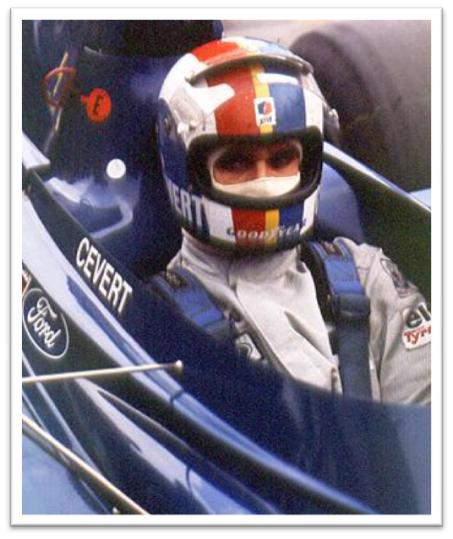
When Jackie Stewart had a hard time getting around François Cevert in an F2 race at Crystal Palace in 1969, Stewart told his team manager Ken Tyrrell to keep an eye on the young Frenchman. This personal recommendation was to pay off in 1970, as when Tyrrell needed a new driver at short notice Stewart’s recommendation was still in his mind. Tyrrell later commented on the reason for Cevert’s appointment to the Formula One team that “everybody said it was [French oil company and Tyrrell sponsor] Elf, but it was really what Jackie said about him.”
When Johnny Servoz-Gavin suddenly retired from the Tyrrell Formula One team three races into the 1970 season, Tyrrell called upon Cevert to be his number two driver, alongside defending World Champion Stewart. Over the next four seasons, Cevert became the veteran Stewart’s devoted protégé. After making his debut at the Dutch Grand Prix at Zandvoort in Tyrrell’s second customer March-Ford, he increased his pace and closed the gap to Stewart with virtually every race. He earned his first World Championship point by finishing sixth in the Italian Grand Prix at Monza.
In 1971, with the Tyrrell team now building their own cars, Cevert finished second in France and Germany, both times behind team leader Stewart. Then, in the season-ending United States Grand Prix at the newly-extended Watkins Glen race course, the Frenchman earned his first and only Grand Prix win. Cevert became only the second Frenchman to win a Formula One World Championship Grand Prix (Maurice Trintignant won at Monaco in 1955 and 1958), and it was the high point of his career, helping him take third place in the 1971 Driver’s Championship behind Stewart and Ronnie Peterson.
Great expectations for Cevert, Stewart and Tyrrell were not fulfilled in 1972 as Emerson Fittipaldi and Lotus won the Driver’s and Constructor’s Championships. Cevert finished in the points only three times, with second places at Belgium and the US, and a fourth at his home race in France at the Clermont-Ferrand circuit. One bright spot in a disappointing year for Cevert was his second place finish at the 24 hours of Le Mans, driving a Matra-Simca 670 with New Zealand’s Howden Ganley.
In 1973, the Tyrrell team was back on top in Formula One and Cevert showed he was capable of running with Stewart at almost every race. He finished second six times, three times behind Stewart, who acknowledged that, at times, the Frenchman had been a very “obedient” teammate. As Cevert began to draw even with Stewart’s driving abilities, the Scot was secretly planning to retire after the last race of the season in the United States. For the 1974 season, Cevert would be Tyrrell’s well deserving team leader.
Tragically, at Watkins Glen, with Stewart having already clinched his third World Championship, Cevert was killed during Saturday morning qualifying, while battling for pole position with Ronnie Peterson. In the fast right-left uphill combination called “The Esses” Cevert’s car was a little too much toward the left side, getting a bump from the curbs described by Niki Lauda in his book The Art and Science of Grand Prix Driving as unbelievably dangerous (the curbing at the circuit was not changed until 2005 when the Indy Racing League began racing at the circuit). Due to the bump, Cevert’s car swerved too much to the right-hand side of the track, where it touched the track’s signature powder blue safety barriers causing the car to spin and crash into the barriers on the other side of the track at a near 90° angle, uprooting and lifting the barrier. Cevert died instantly of massive injuries inflicted by the barrier.
Jackie Stewart was one of the first on the scene of Cevert’s accident and said later “They had left him [in the car], because he was so clearly dead.” When practice resumed, Stewart went out on the track in his car on a personal fact-finding mission. His conclusion was that his preference was to take The Esses complex in fifth gear in the Tyrrell; hence he would be at the low end of the engine’s rev range. Cevert however preferred to use fourth gear and be at the top end of his engine’s power range: it was always something of a compromise because of the need to accelerate through the combination of corners. Stewart noted that the Tyrrell always felt jumpy through this section of the Watkins Glen track owing to its short wheelbase; he felt that this was somewhat counteracted by driving in the higher gear even though this meant a time penalty if he got his line wrong through the corner. Thus Cevert’s driving technique may have been a contributory factor in the accident. Stewart did not run his final race because of Cevert’s death.
Cevert was 29 years and 224 days old. François Cevert is buried in the Cimétière de Vaudelnay in the village of Vaudelnay, Maine-et-Loire. His grave is covered with a brass of fine black marble and a black relief attached to the wall behind showing his portrait.
Francois Cevert – The Destiny of a Prince (Part 1 of 3)
Francois Cevert – The Destiny of a Prince (Part 2 of 3)
Francois Cevert – The Destiny Of A Prince (Part 3 of 3)
[Source: Wikipedia]










Wow, nice tribute. I was there that weekend at the Glen. I will never forgwet that day.
bonjour Mitch,
j’écris 1 livre sur F.Cevert, est il possible d’avoir votre témoignage sur le 6 Octobre 1973 ?
Merci pour votre réponse;
christian
my father Joachim Wondras was there at the trial runs the day Francois had his tragic crash at Watkins Glen.
My father has Francois signature on his Watkins Glen ticket, a day my father will never forget.